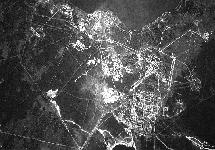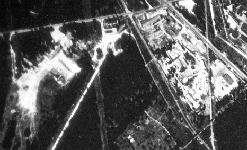Chelyabinsk-65 / Ozersk
Combine 817 / Production Association Mayak
N 55░42' E 60░46'
Production Association 'MAYAK' Leninstr. 31 454065 Chelyabinsk-65 Tel: 7-351-513-1659 Russian Federation Fax: 7-351-513-3826 Director Victor Fetisov Chief Engineer Alexander P. Suslov Dir., Radiochemical Plant Vladimir K. Sazhnov Chief Engineer, Radiochem. Plan Evgeniy G. Dzekun
Chelyabinsk-65 (in the past Chelyabinsk-40), currently Ozersk, was established in 1948 to produce plutonium for nuclear weapons. The construction of the Combine 817, currently the Production Association Mayak, began in 1947. The first production reactor (Reactor A) went into operation in June 1948 and the first batch of plutonium was produced at the radiochemical plant (Plant B) on February 26, 1948. This plutonium was fabricated into nuclear device components at the plutonium finishing plant (Plant V). The Chelyabinsk-65 nuclear complex continued to expand during the next four decades and is currently one of the largest and most diverse nuclear facilities in Russia.
Chelyabinsk-65 is located about 15 km east of Kyshtym, on the east side of the southern Urals in Chelyabinsk oblast. It occupies an area of approximately 200 km2 around Lake Kyzyltash, in the upper Techa river drainage basin among numerous other lakes with interconnecting watercourses. The industrial area bordering the southeastern shore of the lake Kyzyltash, where the plutonium production complex is located, is approximately 90 km2. Ozersk is located 10 km north-east of the plutonium production complex between the Lakes Kyzyltash and Irtyash. Chelyabinsk-65 comprises several other industrial areas related to fissile material storage and processing. Chelyabinsk-65 has a population of 88,000. Approximately 12,000 work at the nuclear facility.
The production of plutonium in Chelyabinsk-65 took place in five uranium-graphite reactors (A, IR-AI, AV-1, AV-2, and AV-3) commissioned between 1948 and 1955. The uranium-graphite reactors were shut down between 1987 and 1990.
In the early years, irradiated fuel from the production reactors was reprocessed at the radiochemical plant B, which began operations on December 22, 1948. The plant is located near the lake Karachai that was used to dump reprocessing high-level waste (currently medium-level waste). The Plant B underwent through several modernization efforts and continued to work until the early 1960s.
The reprocessing of irradiated fuel from the production reactors was continued at the Plant BB, located next to the Plant B. (The two plant subsequently have been combined into a single industrial area - the area 235.) The construction of the Plant BB, which was designed to replace the Plant B, started in 1954. The first production line of the plant BB was completed in 1959. Due to its high productivity it was decided that there was no need to use the second line for the production of plutonium. Instead the second line was adopted to extract isotopes from irradiated targets from the Chelyabinsk-65's isotope production reactors. In 1987, after two out of five production reactors were shutdown, the Plant BB was shut down and the production of weapon-grade plutonium in Chelyabinsk-65 stopped.
The plutonium product of the radiochemical facilities was transferred to the chemical and metallurgical Plant V (the Tatysh plant), which was built in 1948-49 to produce plutonium metal and to manufacture warhead components. The second line of the Plant V was designed to manufacture HEU weapons components. The Tatysh complex is located approximately 20 km south-west of the plutonium production complex. At present, the chemical and metallurgical plant continues to process fissile materials and to fabricate weapons components. In 1997, the plant became involved in blending down HEU from dismantled weapons.
Chelyabinsk-65 was selected as a storage site for fissile materials recovered from dismantled nuclear weapons. The storage facility, which is currently being constructed with U.S. assistance, is located between Lake Kyzyltash and Reservoir 10 on the south side of the river Techa and east of the plutonium production complex.
Chelyabinsk-65 has also been producing tritium and other special isotopes. At present, tritium and other isotopes (plutonium-238, cobalt-60, carbon-14, irridium-192, and others) are produced by the reactors "Ruslan" (start-up in 1979), and "Ludmila" (start-up in 1986-87).
Tritium is transferred to the Mayak's tritium plant, producing tritium components of nuclear warheads. The isotopes are transferred to the radioisotope plant (in operation since 1962), which manufactures alpha-, gamma-, and beta radiation sources, plutonium-238 and strontsium-90 thermal generators, and a wide range of radionuclides.
The RT-1 plant brought into operation in 1976 absorbed parts of the Plant B. At present, three production lines of the RT-1 plant reprocess spent LEU fuel from VVER-440 reactors as well as HEU fuel from BN-600, naval propulsion, research and material production reactors. In addition to reprocessing of spent fuel, the RT-1 plant is a storage site for approximately 30 t reactor-grade plutonium, and is involved in radioactive waste management, and research and pilot production of uranium-plutonium MOX fuel.
In 1984, the Soviet Union began the construction of three BN-800 fast breeder reactors (located at the north-western edge of the reservoir 10) and an industrial-scale MOX fuel fabrication facility (Area 300). The construction of the partially-built facilities was stopped in 1989 because of the lack of funding and public opposition.
Chelyabinsk-65 has a number of natural and man-made reservoirs that have been used in various periods to dump nuclear waste. In the early period, medium-level waste from the radiochemical complex was dumped directly into the Techa river, which originates from Lake Kyzyltash (reservoir 2, which was used as a source of cooling water for the plutonium production reactors). In September 1951, a new solution was adopted: instead of dumping waste into the Techa river, the waste was diverted to lake Karachai. Between 1951 and 1964 a cascade of four artificial reservoirs (3, 4, 10, 11) were created along the Techa, just below Lake Kyzyltash to retain radioactivity already discharged.
Chelyabinsk-65's primary facilities are supported by an extensive research and technological infrastructure, including the central plant laboratory, device-building plant, tool-building plant, machining and repair shop, and specialized construction unit.
Environmental Impact
During the late 1940s and the early 1950s nuclear material production resulted in major releases into the environment and significant overexposures for thousands of workers and nearby populations. Chronic radiation sickness was observed early in exposed workers, and increases in leukemia and other cancers were also reported. The series of plutonium inhalation-related lung cancers and fatalities among workers exposed in that first decade appears to be unique. Long-term consequences of chronic radiation sickness and four decades of follow-up are being described for the first time. Villagers downstream from the plant consumed high levels of 137Cs and 90Sr and, it is reported, manifested increases in leukemia from internal and external exposures.
Since 1949 the Production Association Mayak had handled the burial of spent nuclear fuel. Between 1949 and 1956 PO Mayak dumpted liquid radioactive waste directly into the Techa River, which flows into the Tobol River and Arctic Ocean. Over a seven year period a total of 2.75 million curies of waste was disposed by this means. Subsequent health concerns led to the disposal of liquid waste in nearby akes. Lake Karachay accumulated some 120 million curies of radioactivity and over 7,000 local residents who had received from 3.5 to 170 REMs were relocated.
On 29 September 1957 a chemical explosion in the radioactive waste storage site involved some 20 million curies of material. When the cooling system of a radioactive waste containment unit malfunctioned, a concrete barrier restrained most of this material. But some 2 million curies spilled across Chelyabinsk, Sverdlovsk, and Tyumen Oblasts covering a total area of 23,000 square kilometers inhabited by a quarter of a million people. Emergency measures including evacuation of the population were taken to limit serious health effects. Significant radioactive contamination covered an area of more than 800 square kilometers, and there are areas where the concentration of Cesium-137 and Strontium-90 are still hazardous to human health.
And in the spring of 1968 Lake Karachay began to dry up, and the wind carried away a substantial volume of radioactive dust, irradiating half a million people with five million curies.
Imagery Evaluation Report
As of 07 October 2000 the Space Imaging Carterra Archive had a dozen images of this area, of which four were cloud-free.



























Sources and Methods
- Thomas Cochrane, William Arkin, Robert Norris and Jeffrey Sands, Soviet Nuclear Weapons Nuclear Weapons Databook Volume IV, Natural Resources Defense Council [New York, Harper & Row, 1989].
- Thomas Cochrane, Robert Norris and Oleg Bukharin, Making the Bomb - From Stalin to Yeltsin [Boulder, Westview Press, 1995]
- MAYAK PRODUCTION ASSOCIATION
- Ozersk / Mayak Chemical Combine Bellona Working Paper no. 4:95. Written by: Nils B°hmer og Thomas Nilsen
- Chelyabinsk - The Most Contaminated Spot on the Planet
- Chelyabinsk Russia - Environmental Links and Maps
- The Russian Radiation Legacy: Its Integrated Impact and Lessons Marvin Goldman Environmental Health Perspectives 105, Supplement 6, December 1997
- Data Analysis and Physicochemical Modeling of the Radiation Accident in the Southern Urals in 1957 , S. A. Kabakchi, A. V. Putilov and Ye. R. Nazin, ATOMNAYA ENERGIYA, January 1995
- Status of Mayak Nuclear Waste Disposal Facility, Katarina Koivisto , Hufvudstadsbladet, 3/28/1997 -- Mayak, the Russian facility for nuclear waste disposal in the northwestern Urals, has been forced to close one line for lack of funds.
- Sleep of Nuclear Giants, Vladimir Gubarev , ROSSIYSKAYA GAZETA, 4/8/1997 -- Development of Plutonium-Producing Reactors Detailed
- INTRODUCTION TO CHELYABINSK AMERICAN BUSINESS CENTER - CHELYABINSK April 1996
- Chelyabinsk-65 / Ozersk 2000/07/16 2000071607022070000011628206
- Chelyabinsk-65 / Ozersk 2000/06/21 2000062106513660000011611998
- Chelyabinsk-65 / Ozersk 2000/02/21 2000022106381810000011621102
- Chelyabinsk-65 / Ozersk 2000/02/03 2000020307205850000011615265
|
NEWSLETTER
|
| Join the GlobalSecurity.org mailing list |
|
|
|

